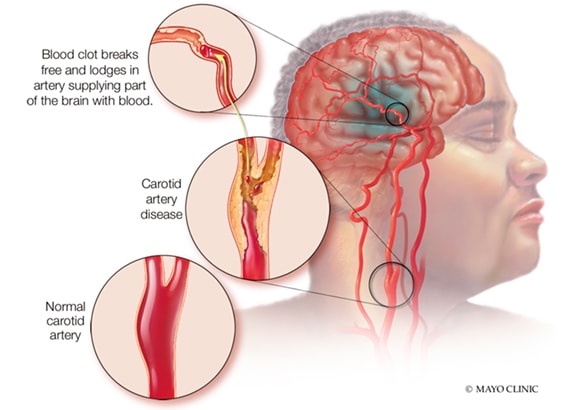Dec. 11, 2018
Kevin M. Barrett, M.D., a neurologist at Mayo Clinic in Jacksonville, Florida, answers questions about the CREST-2 study comparing methods of stroke prevention. Mayo Clinic is the clinical coordinating center for this multicenter, randomized study sponsored by the National Institute of Neurological Disorders and Stroke (NINDS).
Is CREST-2 still enrolling patients?
Yes — we've already randomized more than 1,100 patients into the study, but our target recruitment is 2,480 patients. At this point in the trial, we have a lot of momentum, with more than 120 centers in North America currently enrolling patients. We're continuing to enhance our recruitment efforts nationwide, not only in neurological practices but also in primary care, cardiology and vascular surgery offices across North America.
What are the criteria for enrollment?
كيفية تسبب مرض الشريان السباتي في السكتة الدماغية

كيفية تسبب مرض الشريان السباتي في السكتة الدماغية
تعرض الرسوم التوضيحية العملية التي من خلالها يؤدي مرض الشريان السباتي إلى السكتة الدماغية.
CREST-2 is designed to identify the optimal approach for stroke prevention in patients with high-grade asymptomatic carotid stenosis. We're recruiting men and women who:
- Are ages 35 and older
- Have 70 percent or greater narrowing of at least one carotid artery
- Lack other serious medical complications
What are the potential benefits for patients who enroll in CREST-2?
Because of the current uncertainty with respect to the optimal approach to stroke prevention, we feel that the best treatment for patients with high-grade asymptomatic carotid stenosis is enrollment in CREST-2.
CREST-2 is designed as two parallel clinical trials — one comparing treatment with intensive medical management alone versus intensive medical management combined with carotid endarterectomy, the other comparing intensive medical management alone versus intensive medical management combined with carotid angioplasty and stenting. The aim is to measure treatment differences between intensive medical therapy alone and intensive medical therapy plus carotid revascularization.
We're also following cognitive outcomes in patients enrolled in CREST-2. It might be that one of the approaches in the study is better at preserving cognition in these patients.
How does the structure of CREST-2 help ensure that participants receive optimal care?
CREST-2 is unique because it builds upon the experience of CREST — the multicenter Carotid Revascularization Endarterectomy Versus Stenting Trial. Like CREST, CREST-2 uses rigorous credentialing of proceduralists before their participation to ensure that the patients receive optimal surgical care as well as optimal medical care.
Most of our CREST-2 clinical sites have experience providing both carotid endarterectomy and carotid angioplasty and stenting. But if a center happens to specialize in one type of carotid revascularization, the center can still participate in CREST-2. The parallel structure of CREST-2 helps augment the ability of sites to participate and ensure that participants who have carotid revascularization are treated by experienced providers.
CREST-2 also has ongoing oversight from an independent Data Safety and Monitoring Board.
At CREST-2's most recent review, the board found no safety concerns for patients in the study and was enthusiastic about our continuing it.
How have the CREST-2 protocols been updated?
We're keeping pace with the changes occurring in routine clinical practice with respect to intensive medical therapy and neuro-imaging. Over the course of the study, the protocols for CREST-2 procedures have been modified to incorporate the newest generation of lipid-lowering medications and contemporary neuro-imaging studies. We want to ensure that the study results are informative and relevant.
What strengths does Mayo Clinic bring to this large, NINDS-funded research?
As the clinical coordinating center for CREST-2, we're drawing on our experience as a coordinating center for CREST. We're also taking advantage of our large footprint in North America, and the relationships across the Mayo Clinic campuses in Arizona, Florida and Minnesota. Our historical and institutional experience puts us in a position of leadership.